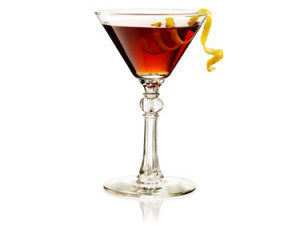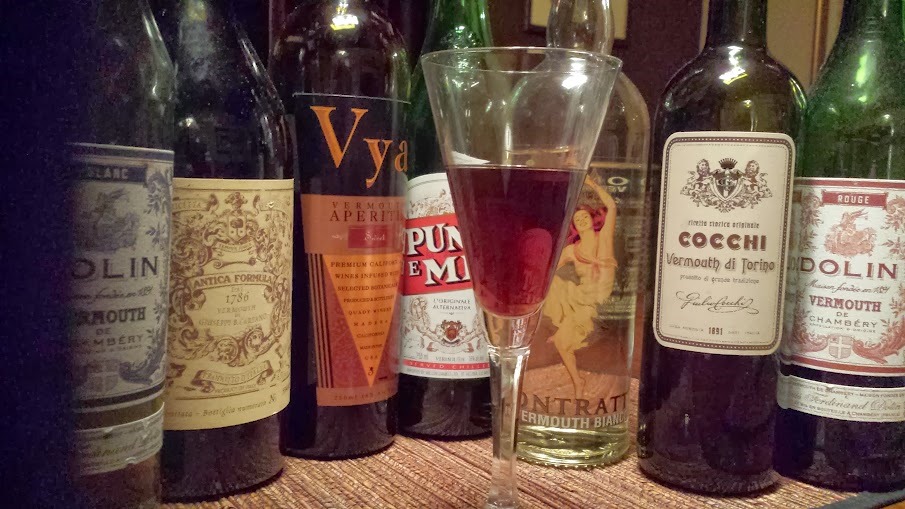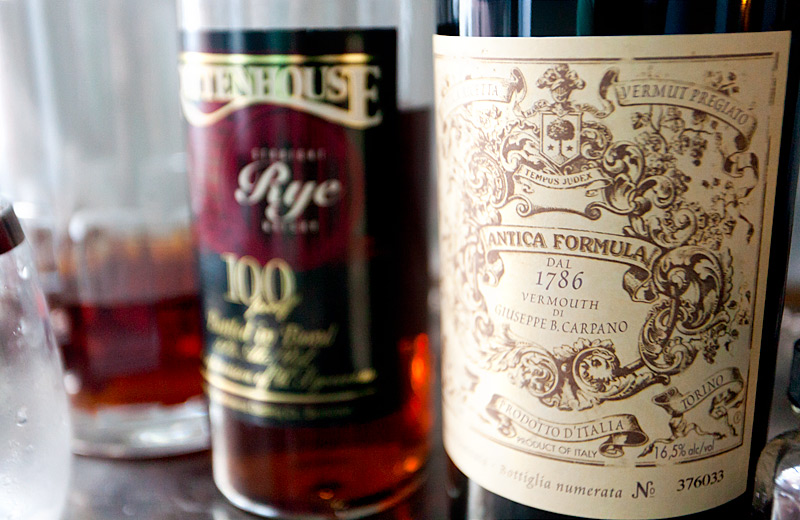Last month, we looked at hot cocktails in a cold season, but winter libations are about more than just temperature. When the thermostat is bottoming out, I like my drinks to have some heft to them. The flavors are bold, with darker sweet notes and warm spices, and definitely with a nice heavy dose of herbs.
 Which is why I love a good drink with sweet vermouth at this time of year. Granted, it’s an all-year, all-season love, but there’s something particularly satisfying about sweet vermouth in the winter. And here’s why I think you should join me in imbibing this lovely fortified wine.
Which is why I love a good drink with sweet vermouth at this time of year. Granted, it’s an all-year, all-season love, but there’s something particularly satisfying about sweet vermouth in the winter. And here’s why I think you should join me in imbibing this lovely fortified wine.
Get To Know Your Vermouth
Since I’m excoriating you to drink it, we should get to know our sweet vermouth. Vermouth is an aromatized wine, which is itself a type of fortified wine. The “fortified” part means the wine has had its alcohol content increased by the addition of a distilled spirit (often brandy or neutral spirits). Fortification also means that the wine will keep a bit longer than your standard wine, though we’ll come back to this later.
An “aromatized” wine means that this particular aperitif is also flavored with a bunch of herbs, spices, roots, and the like. Further delineation of an aromatized wine depends on the base wine and the herbs added. The sweet (or Italian) style is dark, reddish, spicy, and richly herbal. The dry (or French) style is pale, light, floral, and refreshing with a bit of a bite. You might think of them as a cola versus a light citrus soda.
As for “vermouth,” that comes from a bastardized version of wermut, the German word for wormwood (artemisia absinthium). This bitter herb was a common ingredient in the first vermouths, and the current European definition of vermouth specifies the inclusion of an artemisia of one sort (or another). The American definition is less specific, and this has lead to a bit of sniping across the Atlantic by those who make aromatized wine.
For the moment, we’re putting the spotlight on the sweet version. The dry will get its turn, don’t worry. But it’s the seasons for the dark and full-bodied expression.
Living With Your Vermouth
Now that you know what vermouth is, what version of the sweet stuff should you get? Unfortunately, you’ll often be at the mercy of a store’s selection. But if that store is a Binny’s (or other large regional liquor retailer), then you have the opposite problem. Personally, my go-to sweets are Cocchi Vermouth di Torino or American-made Vya. I like Dolin Rouge as an inexpensive option, and Carpano Antica as an expensive one. If I’m lucky, I might run across a bottle of something unique, like Atsby’s Armadillo Cake or anything from Uncouth Vermouth.
Your tastes may differ, which is all the more reason to try vermouth outside of a cocktail. Trust me, it’ll be okay, as long as it’s relatively fresh. You’re not using years-old vermouth are you? Are you?! Hmmm, maybe we should talk shelf-life and storage.
Yes, vermouth is a fortified wine, and as such will keep longer than a bottle of regular wine. Yes, that bottle of sweet vermouth you’ve had on your shelf for a year is probably okay. But “okay” doesn’t mean “good.” Vermouth will oxidize, meaning it’ll lose its depth of flavor after a time, and eventually lose anything resembling a good flavor.
As a general rule, once you open a bottle of vermouth, it goes into your refrigerator at the end of the night. It’ll still be good for a month or three, after which — at some point — it’ll start tasting “off.” If you drink enough vermouth, you’ll be able to taste this as it’s happening. If it’s starting to slide, that’s the time to call friends over for a night of Manhattans and Negronis.
There are other ways to combat the decline of a bottle of vermouth. You can vacuum-seal it like you might with regular wine. You can decant it into separate jars, so as to have reduce the amount of air to oxidize it. More and more brands are selling 375 mL bottles, so that you there’s less to potentially waste.
My favorite is to simply drink vermouth on a regular basis, and the cocktails below can help you in such an endeavor.
The Manhattan
Of course we start with the Manhattan. It’s a classic drink that’s simple, with proportions that can accommodate different whiskies, and it’s utterly delicious. If I’m mixing, I’m making it with the standard 5:2 ratio of whiskey (usually rye) to sweet vermouth, a healthy dash of bitters, and either an orange peel or brandied/maraschino cherry for garnish. That vermouth ratio is fungible to me — if I start with 2 ounces of whiskey, I’ll either go with a “heavy” ¾ ounce or a “light” 1 ounce of vermouth. It depends on my mood and/or the taste of the person I’m mixing for. Ditto on the bitters. Angostura orange is my default, but I’ll often stray to Boker’s, Bittercube’s cherry bark vanilla, or Jerry Thomas’, or barrel-aged…
Sorry, got off-track there. The beauty of the Manhattan is that you can tweak it with your choice of vermouth or whiskey or bitters, tailoring it to what dances on your tongue. If you change the whiskey to a Scotch whisky, you have a Rob Roy. If you specify that the whisky is an Ardbeg and the vermouth a Cocchi Vermouth di Torino, I don’t know that it has a name. I only know it is a dream wrapped in smoke and bitter lushness.
But you can go even further afield, such as the Newark cocktail from Jim Meehan and John Deragon (of PDT fame). This variation uses apple brandy instead of whiskey, and replaces the bitters with some maraschino liqueur and Fernet Branca. And if you really want something that’s a bit crazy (yet simple), grab your bottle of celery bitters and follow along with Canon’s Jamie Boudreau:
I have a fondness for this particular cocktail, as it was the first time I went hunting for a specific ingredient just to make a drink I found in a book. For those who can’t watch video, or want to copy/paste the recipe, here it is.
Fourth Regiment Cocktail
1 oz — 100-proof rye whiskey
1 oz — sweet vermouth
dash of orange bitters
dash of Peychaud’s bitters
dash of celery bitters
Combine the ingredients in a glass, add ice, and give it a good stir. Strain into a chilled cocktail glass, and garnish with a lemon twist.
Or if you want to abandon aged spirits altogether, may I suggest…
The Martinez
I can’t talk about sweet vermouth without bringing back my favorite cocktail. I used this recipe back during the World Cup cocktail series, and I revisit it here. Theoretically, a Martinez is (more or less) a Manhattan variation using (Old Tom) gin instead of whiskey. But what makes it apropos to this discussion is the ratio of vermouth used in the recipe. Adam Elmegirab traced the trend in tastes (via the Martinez) that saw vermouth-forward cocktails give way to jokes about how little vermouth a recipe uses. Buck the trend. Try a cocktail that gives top billing to vermouth.
Old Tom gin isn’t the most common ingredient, but can be found without too much trouble — especially with the advent of craft distilleries. The aforementioned Elmegirab also makes the once-defunct bitters that this drink calls for, which truly makes this drink sing.
Martinez
2 oz — sweet vermouth
1 oz — Old Tom gin
bar spoon of Luxardo maraschino liqueur
couple dashes of Boker’s bitters
Combine all ingredients into a pint glass. Add ice, stir until nice & cold, and strain into a chilled cocktail glass. Garnish with a swath of lemon or orange peel.
We could continue all day down this path, talking about the Negroni and it’s cousin the Boulevardier, but we could also ditch the spirits altogether and look at lighter vermouth-centric drinks.
Something a Little Lighter
While the Martinez may be my favorite, the cocktail I drink the most of is the Americano. Equal parts sweet vermouth and Campari, over ice and topped with sparkling water, this satisfying drink is the perfect libation any time of day. If you want something sweeter, replacing the Campari with Aperol will give you a light drink with a bit of citrus.
Speaking of, another option instead of Campari or Aperol is Citron Sauvage, a bitter grapefruit liqueur from New York-based Bittermens. This liqueur plays very well with sweet vermouth — if you follow that link, you’ll see the Stiry, a Boulevardier variation that doesn’t skimp on vermouth.
For this riff on an Americano, I go sweet (relatively speaking):
Paradisi City
2 oz — sweet vermouth
½ oz — Cointreau
¼ oz — Citron Sauvage
club soda
Build in a highball glass (or a narrow Mason jar) over ice. Garnish with half an orange slice.
The bitter liqueur is a smaller proportion, tempered with Cointreau. With this recipe, the vermouth needs to be able to stand on its own. The bottom-shelf stuff won’t cut it. When you find the aromatized wine you like, this cocktail will ensure that it doesn’t languish on the shelf to oxidize.
And if you don’t have a favorite sweet vermouth yet? All the more reason to pick up some 375s and get tasting.









